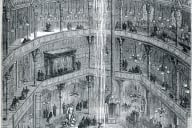You have /5 articles left.
Sign up for a free account or log in.
Every so often, it hits home that we are actually living in one of those science-fiction worlds that I read about as a young nerd in the 1970s. Not, it turns out, one where we commute with jet packs; nor are Soviet and American colonists bantering about just how red the Red Planet should be. But now, while putting my keys in my pocket, I will sometimes accidentally hit a button on the BlackBerry that causes a robotic female voice to bark, “Say a command!”
Never having gotten around to programming any in, it always feels like I’m letting her down.
We’re all walking around carrying devices that are in contact with unimaginably vast systems of information. You get used to it. It ceases to seem strange – which is, arguably, the strange part. Future shock becomes second nature. (To remember what things were like before requires something like the exact opposite of the willing suspension of disbelief.) And discussing any of this with friends or colleagues in their 20s is out of the question. It leaves me feeling like I have become my own grandfather.
So the decision to start using an e-book reader involved more than the usual semi-curmudgeonly ambivalence. I’m not interested in giving any free advertising by naming which model. Besides, by the time this column appears, I will just barely have started testing it, so recommendations aren’t in order. The salient point, rather, is that something I probably first read about in Isaac Asimov’s Science Fiction Magazine in 1978 is about to become part of the texture of everyday life. It bears recognizing this now, before the familiarity takes over.
Food, sex, and reading are among the fundamental pleasures in life. By a certain point, your tastes are pretty well established, if not hopelessly inflexible. For the past couple of years, I’ve avoided digital books on the grounds that e-readers were too expensive, but that was, in fact, a bit of an evasion, since the whole idea was rather off-putting. It’s not like you start eating fried grasshoppers or join a bondage club just because someone gives you a half-price coupon.
No, the decision to plunge that much deeper into the 21st century had another motivation – one with roots in the mid-1970s, as it happens.
For it was back then that some futurologist writing in a popular magazine argued that the energy crisis and stagflation might put an end to book publishing within a couple of decades. His other predictions were just as bad, unless there is a lot more cannibalism going on now than you hear. But I was a kid, and impressionable, and it’s fair to say that his article left a mark at levels where later rationality does not reach. A kind of literary and intellectual survivalism kicked in. Shelves are for hoarding. When the apocalypse came, I’d be ready.
The energy crisis passed, of course, and the books kept coming. But space is the one thing they aren’t making any more of – not in our apartment, anyway. The e-book reader is a kind of compromise with reality. There are things you skim, or read once and promptly forget. And there are books you revisit, live with, obsess over. Best to have durable ones in durable form -- and the ephemera (journalistic or academic, as the case may be) as bytes on a chip.
There is a striking chart in Merchants of Culture: The Publishing Industry in the Twenty-First Century by John B. Thompson, a professor of sociology at the University of Cambridge. The book, forthcoming from Polity in October, is a thorough and thoughtful analysis of publishing as a relatively self-contained world -- a "field" obeying rules that are ultimately economic, but in ways refracted through maneuvers and conflicts that defy simple cost-benefit analysis. Anyone interested in publishing will want to read it. For now, that means in hardback, since it is not available in any other format just yet.
But it is the few pages on e-books that I want to turn to for the moment -- and in particular the bar graph on page 317. It shows the wholesale revenue for e-book sales in the United States, by quarter, between 2002 and 2009. For most of that period, the market barely has a pulse. Quarterly sales of more than 10 million dollars only begin at the start of 2008. But then it takes off, accelerating to nearly six times that much by the final quarter of 2009.
This is still a tiny portion (at present about 3 percent) of total book sales. “Moreover,” Thompson notes, “the new reading devices have not been around long enough to know whether the upsurge in e-book sales that followed their introduction was a temporary blip generated by the novelty of the devices and their intensive promotion or the beginning of a sustained pattern of sales growth.” Making predictions about sales over a five year period is, he says, “like trying to predict the weather in six months’ time,” given that “so many incalculable factors, from as yet unknown technological innovations to the habits and tastes of readers, are in play.”
The avoidance of fatalism is smart -- as indeed the whole book is. It gives added force to his warning about the possible downside of this brave new world: the danger that "content" might become "cannon fodder for large and powerful technology companies that use content to drive the sales of their devices and services, thereby devaluing intellectual property and sucking value out of the content creation process."
The true crystallization of such value, it still seems to me, takes the form of concrete, three-dimensional artifacts made of paper. But that is a matter of "habits and tastes" formed in another era. The possibility of carrying around a small device containing an enormous library was tremendously appealing to me as a kid. So was the format in which that idea was expressed -- ink on pulp, the page likely to disintegrate long before the world it predicted would ever arrive.




